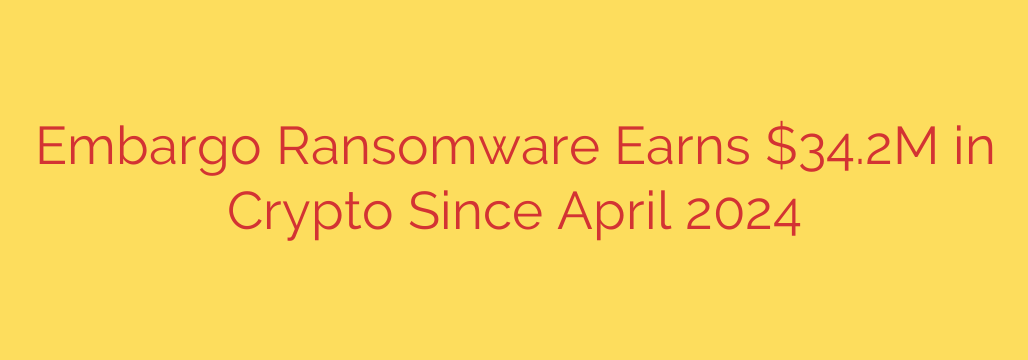
Embargo Ransomware: What You Need to Know About the $34 Million Cyber Threat
A new and highly aggressive ransomware strain known as Embargo has emerged as a significant threat to businesses and organizations worldwide. Since it was first detected in April 2024, this malicious software has already extorted over $34.2 million in cryptocurrency payments from its victims, signaling a rapid and alarming rise in the cybercrime landscape.
This ransomware operates with ruthless efficiency, infiltrating networks, encrypting critical data, and grinding business operations to a halt until a hefty ransom is paid. Its rapid success highlights a sophisticated operation that demands immediate attention from IT professionals and business leaders alike.
How Does Embargo Ransomware Work?
Like many of its predecessors, Embargo ransomware primarily targets organizations through common but effective attack vectors. Understanding these methods is the first step toward building a strong defense.
Attackers deploying Embargo typically gain initial access through:
- Phishing Campaigns: Crafty emails designed to trick employees into clicking malicious links or downloading compromised attachments.
- Exploiting Software Vulnerabilities: Targeting unpatched software, operating systems, and network devices to gain an unauthorized foothold.
- Weak Remote Access Security: Compromising poorly secured Remote Desktop Protocol (RDP) ports or other remote access tools that lack multi-factor authentication.
Once inside a network, Embargo moves laterally to identify and encrypt high-value data, including databases, financial records, and intellectual property. The attackers then leave a ransom note demanding payment in cryptocurrency, leveraging its anonymity to evade law enforcement. The sheer profitability and speed with which Embargo has generated millions of dollars indicate that its encryption methods are effective and that many victims feel they have no choice but to pay.
The Financial Fallout and Why It Matters
The figure of $34.2 million in just a few months is more than just a number—it’s a clear indicator of the ransomware’s effectiveness and the scale of the threat. This level of financial success will undoubtedly fuel the attackers’ operations, allowing them to refine their tools, expand their reach, and target even more victims.
For any organization, a ransomware attack is a catastrophic event. The costs extend far beyond the ransom payment itself and often include:
- Operational Downtime: Days or even weeks of lost productivity and revenue.
- Data Recovery Costs: The expense of restoring systems from backups, if they are even available.
- Reputational Damage: Loss of customer trust and confidence.
- Regulatory Fines: Potential penalties for data breaches, depending on the industry and jurisdiction.
Actionable Steps to Protect Your Organization from Ransomware
Proactive defense is the only reliable strategy against threats like Embargo. Waiting to act until after an attack is too late. Here are critical security measures every organization should implement immediately.
1. Implement a Robust Backup Strategy
Your data is your most valuable asset. Follow the 3-2-1 backup rule: keep at least three copies of your data, on two different types of media, with one copy stored securely offline and off-site. Regularly test your backups to ensure you can restore them successfully in an emergency.
2. Strengthen Email and Endpoint Security
Since phishing is a primary entry point, deploy advanced email filtering solutions to block malicious messages before they reach your employees. Additionally, use a modern Endpoint Detection and Response (EDR) solution that can identify and block suspicious behavior characteristic of ransomware.
3. Conduct Continuous Security Awareness Training
Your employees are your first line of defense. Train them to recognize and report phishing attempts, avoid suspicious links and downloads, and practice good password hygiene. A well-informed workforce is significantly less likely to fall victim to social engineering tactics.
4. Enforce Strict Patch Management
Attackers thrive on unpatched vulnerabilities. Establish a formal process to keep all software, operating systems, and firmware updated. Prioritize patching for critical and internet-facing systems to close security gaps before they can be exploited.
5. Secure All Remote Access Points
If your organization uses RDP or other remote access tools, ensure they are properly secured. Mandate the use of multi-factor authentication (MFA), use strong and unique passwords, and restrict access only to authorized personnel.
6. Develop and Practice an Incident Response Plan
Know exactly what to do the moment a breach is detected. An incident response plan should outline the specific steps to take, from isolating affected systems to contacting law enforcement and legal counsel. Knowing who to call and what to do can dramatically reduce the impact of an attack.
The rise of Embargo ransomware is a stark reminder that cyber threats are constantly evolving. By taking these defensive measures seriously, you can build a resilient security posture that protects your data, your finances, and your reputation.
Source: https://securityaffairs.com/180981/cyber-crime/embargo-ransomware-nets-34-2m-in-crypto-since-april-2024.html








